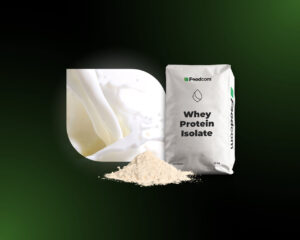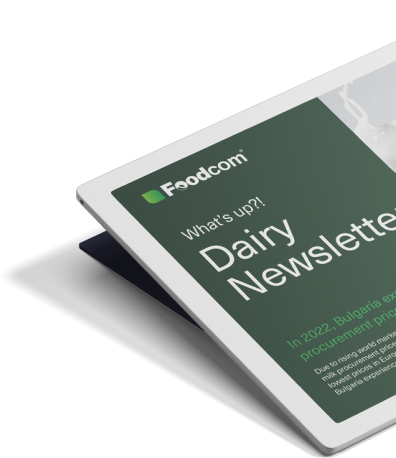- Milk supply remains exceptionally high across major regions, driving persistent price pressure.
- Fats and powders weaken further as spot demand stays limited and stocks accumulate.
- High-protein ingredients remain the strongest segment due to structurally tight availability.
Welcome Partners!
Welcome back to our newsletter!
Global dairy markets continue to face significant pressure as milk supply remains exceptionally high in Europe, the US and Oceania. Milk purchases remain clearly above previous expectations, supporting high production levels at a time when most buyers have already secured supplies for the fourth quarter, first quarter and often well into the second quarter of 2026. With limited spot activity and rising stocks, downward pressure persists across most product groups.
Export channels remain key to surplus management, but strong competition between major exporting regions and unfavourable exchange rate fluctuations, particularly for Europe, continue to hamper pricing. As we approach the end of the year, the market is characterised by high supply, moderate demand and a broadly pessimistic outlook for early 2026.
Milk powder
The milk powder market remains burdened by a persistent oversupply. Skimmed milk powder remains stable in the €2,000-2,100/MT range, although sentiment remains weak as production remains elevated in all major regions and buying interest is cautious.
SMP for feed is lagging behind, with recent transactions recorded in the EUR 2000-2050/MT range, with limited additional demand.
Further declines in milk concentrate prices are further reducing production costs. Skimmed milk concentrate has fallen to EUR 1300-1400/MT, with pre-Christmas transactions even below this range.
Whole milk powder is also weakening as the softness of the dairy fat market reduces its value. European prices have fallen to around €3200-3350/MT and demand, particularly from the chocolate and confectionery industries, remains slower at this time of year.
Cheeses
The cheese market has stabilised after the short-lived spot tightening recorded earlier in the season. Strong spot interest in Gouda and Mozzarella is keeping prices in the €3,000-3150/MT range, but buyers are becoming increasingly cautious and confidence that these levels will hold into the new year is waning.
Mozzarella still remains close to EUR 3000/MT, although market sentiment has clearly weakened compared to previous weeks. Cheddar, on the other hand, remains relatively stable, supported by consistent export activity.
Higher cheese production in Europe is also contributing to stable whey availability, limiting the potential for significant cheese price increases in the coming weeks.
Fats
Dairy fats continue to experience the strongest downward pressure across the dairy complex. Butter prices in Europe have fallen to €4350-4550/MT, with recorded transactions both above and below this range, depending on origin and urgency.
Exceptionally high milk availability is driving higher butter production, with surpluses accumulating as exports slow and domestic consumption remains stable at best.
Markets in Oceania and the US show similar trends, with high cream availability and weaker buying interest keeping downward pressure on dairy fats.
Liquids
Liquid dairy components remain heavily oversupplied across Europe. Cream prices fell again this week and are widely discussed at €5200-5300/MT, while year-end deliveries were realised noticeably cheaper.
Skimmed milk concentrate continues to lose ground, with most transactions recorded between €1,200 and €1,400/MT, reflecting abundant raw material availability and weaker dryer demand.
Whey concentrate, on the other hand, remains firmly in the EUR 650-750/MT range, supported by strong demand from the high-protein sector, especially WPC and WPI production.
Whey powder
The whey and protein market continues to show a clear divide between standard whey powders and high-protein ingredients.
Sweet whey powder remains stable, with the food product quoted at €1050-1100/MT and the feed product at €980-1040/MT. Global demand for SWP is moderate, and even lower dry whey production in the US has not been enough to raise prices significantly.
Protein markets present a very different picture.
WPC 35 remains stable around EUR 2600/MT, but WPC 80 continues to strengthen. Limited availability in the USA has redirected global demand to Europe, lifting transaction prices ever closer to the upper levels indicated for the first quarter. WPC instantiated products are also increasing in price, with prices now above EUR 12 500/MT.
WPI remains one of the most expensive dairy proteins, with prices exceeding EUR 20 500/MT. Supply in Europe and the US is very limited and demand from the functional food and nutrition sectors remains extremely strong.
Overall, the protein segment is characterised by structurally limited supply and rising prices, while standard whey powders remain balanced and relatively quiet.
Summary
The dairy market continues to be shaped by an abundant milk supply and limited demand in the short term, which keeps pressure on powders, fats and part of the cheese category. At the same time, high-protein ingredients such as WPC 80 and WPI remain in a tight supply situation, with high prices.
The outlook for the beginning of 2026 will largely depend on how quickly milk purchases decline after the new year and on Europe’s ability to compete effectively in export markets. For the moment, the overall environment remains supply-driven and broadly pessimistic in most commodity categories, with the exception of proteins.
What’s new?
North America
Tamarack Biotics has unveiled an innovative UV-based milk processing technology that can double the shelf life of milk while reducing the need for traditional high-temperature pasteurisation. The method uses ultraviolet light to deactivate micro-organisms, helping to preserve the natural flavour, colour and nutritional value of the product, as well as significantly extending its freshness. The technology can enable producers to reach further markets, reduce losses associated with short expiry dates and improve logistical efficiency throughout the supply chain.
Europe
The European Milk Board (EMB) is calling for the immediate implementation of voluntary cuts in milk production across the European Union, warning that plummeting farmgate prices are once again driving many dairy farms to the brink of bankruptcy. Farmers gathered at the meeting in Brussels stressed that the early capping mechanism was designed to intervene before the price crisis worsens and destabilises the market. The EMB also highlighted the need for stronger milk supply contracts, including a ban on below-cost sales and unambiguous volumes, as well as growing support for initiatives such as Fair Milk, which aims to ensure a fairer distribution of value throughout the supply chain.
![Oversupply persists, dairy markets under strong price pressure [290th Edition Foodcom DAIRY Newsletter] Oversupply persists, dairy markets under strong price pressure [290th Edition Foodcom DAIRY Newsletter]](https://foodcom.pl/wp-content/uploads/2024/05/Foodcom_SA_Dairy_Newsletter_1-1520x760.jpg)





